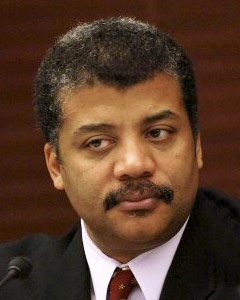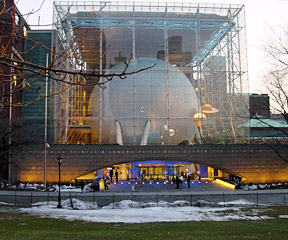
Neil deGrasse Tyson
1958 - Present
American astronomer, astrophysicist, and science communicator.
Director of the Hayden Planetarium and the Rose Center for Earth and Space.
Supported reclassifying Pluto as a dwarf planet, affectionately known as the man who killed Pluto.
Neil deGrasse Tyson is an American astronomer and astrophysicist. He was born on October 5, 1958 in the borough of Manhattan in New York City. He developed an interest in astronomy after a trip to the Hayden Planetarium when he was nine years old. He grew up in the Bronx and attended the Bronx High School of Science. While in high school, he was captain of the wrestling team and editor-in-chief of the school's Physical Science Journal. He took classes at the planetarium and eventually got his own telescope. Tyson continued to pursue his interest in astronomy and would often spend the evenings observing through his telescope from the roof of his apartment building. When he was thirteen, he attended a summer astronomy camp in the Mohave Desert. The dark skies gave him an incredible view of the stars he would never forget. By the age of fifteen, he was already giving lectures on the subject of astronomy. He has said that "so strong was that imprint of the night sky that I'm certain that I had no choice in the matter, that in fact, the universe called me." In 1976 he graduated from high school and began looking to college. Astronomer Carl Sagan tried to recruit him to Cornell University, but he eventually decided to attend Harvard where he majored in physics. He also continued to participate in wrestling and joined the crew team. He received his Bachelor of Arts in Physics in 1980 and began his graduate work at the University of Texas at Austin. After graduating from Austin with a Master of Arts in astronomy in 1983, he returned home to New York to pursue a doctorate degree at Columbia University. He completed his Ph.D. in astrophysics in 1991.

After graduating from Columbia University, Tyson focused his research on stellar evolution and galactic structure. For the next few years he worked as an astrophysicist and research scientist at Princeton University and as a columnist for Stardate Magazine. In 1996 he accepted a position at the Hayden Planetarium at the American Museum of Natural History in New York. He soon became director of the planetarum and was the youngest person to ever hold the position. He worked on an extensive renovation of the facility, assisting with the new design and helping to raise funds. The $210 million project was completed in 2000 and offered visitors a revolutionary new look at astronomy. During the renovation, Tyson made a controversial decision to remove Pluto from the display of planets. He believed that it should be reclassified as a dwarf planet since other similar objects were being discovered in the same region of space. The decision invoked a strong response from visitors, who insisted that Pluto be returned. Some even staged mock protests outside the planetarium. But a few years later in 2006, the International Astronomical Union followed Tyson's lead and labeled Pluto as a dwarf planet. It was official. The Solar System now had only eight planets. To this day Tyson is affectionately considered to be the man who killed Pluto.

Tyson's quick-witted humor and natural charisma has made him extremely popular with the public. He is in many ways the Carl Sagan of the 21st century. He has written a number of books about astronomy. Some of his notable works include Death by a Black Hole and Other Cosmic Quandaries and The Pluto Files: The Rise and Fall of America's Favorite Planet. He has made several appearances on television shows, including PBS' Nova and documentaries created for the Discovery Channel. In 2001, Tyson was appointed by President Bush to serve on a 12-member commission to study the future of the U.S. space program. In 2004, he was appointed again to a 9-member commission on the implementation of the U.S. space exploration policy known as the "Moon, Mars, and Beyond" commission. He is currently scheduled to star in a remake of the wildly popular series Cosmos in early 2014. He continues to do research and has used many telescopes around the world as well as the Hubble Space Telescope. His research interests include star formation, exploding stars, dwarf galaxies, and the structure of our own Milky Way galaxy. He recently published his memoir, entitled The Sky is Not the Limit: Adventures of an Urban Astrophysicist. He has helped to break down the barriers between scientists and the general public and has helped to bring diversity to the study of astrophysics as one of the few African Americans in the field. Tyson lives in New York with his wife and two children where he continues to serve as director at the Hayden Planetarium. He is currently one of the most in-demand science experts, giving talks all around the country. He is famous for injecting a sense of humor into his lectures.




